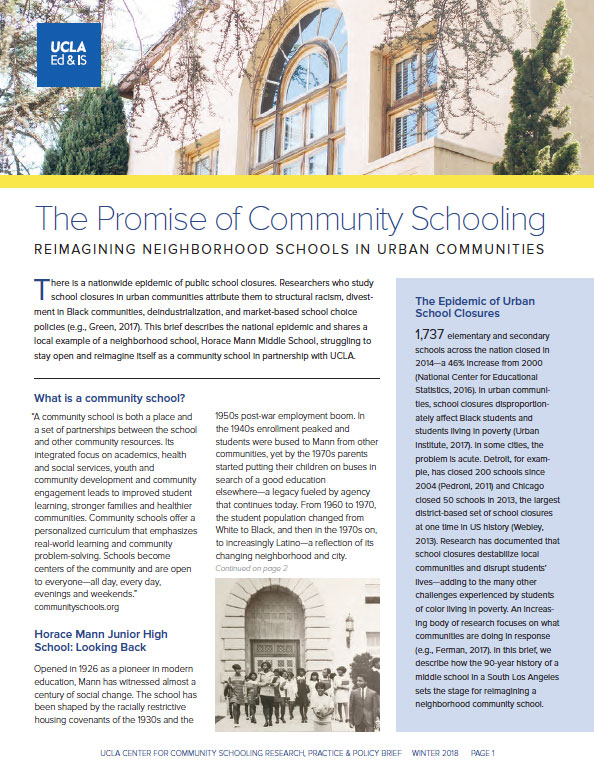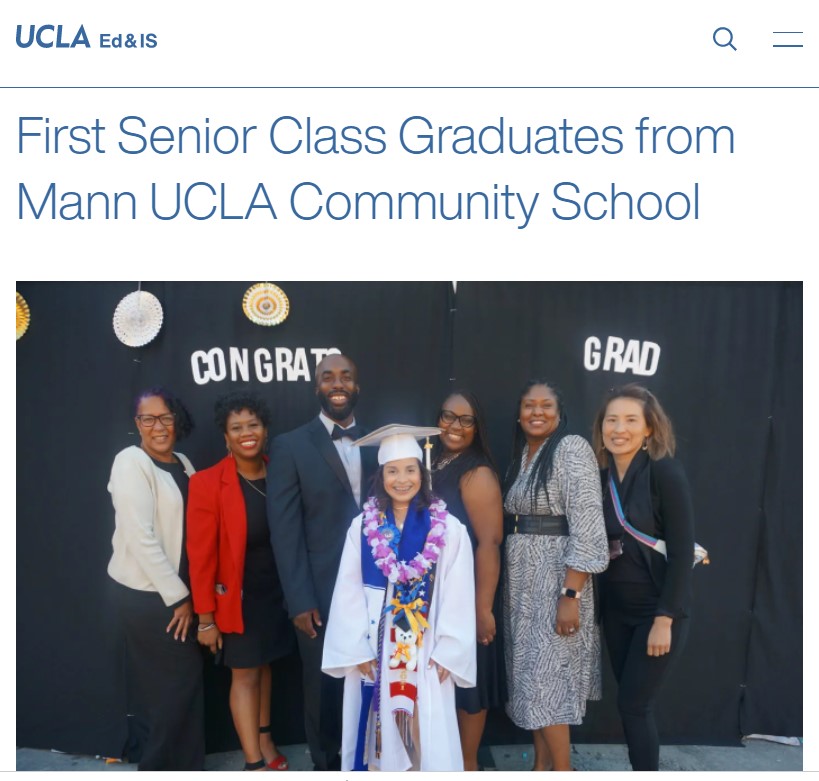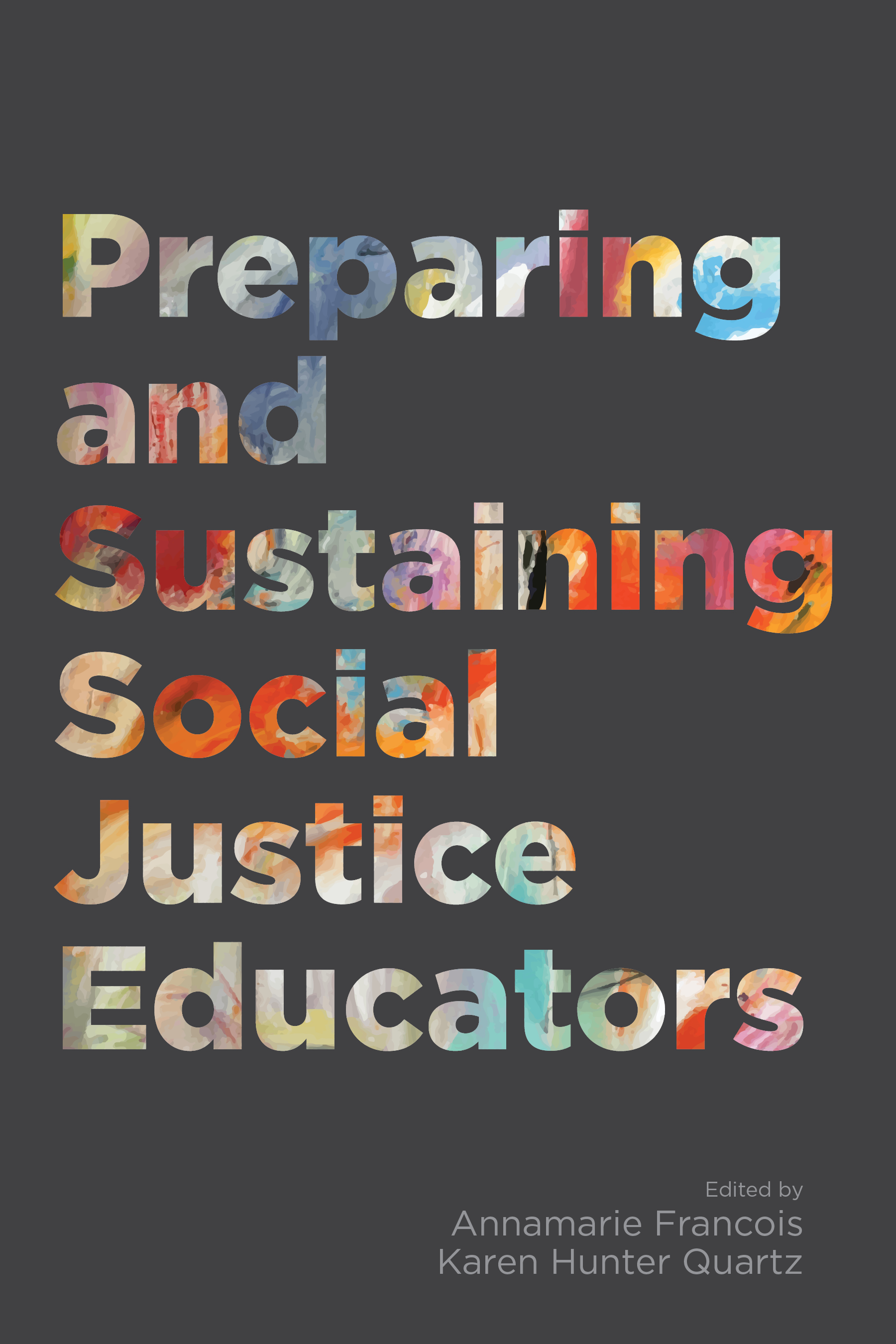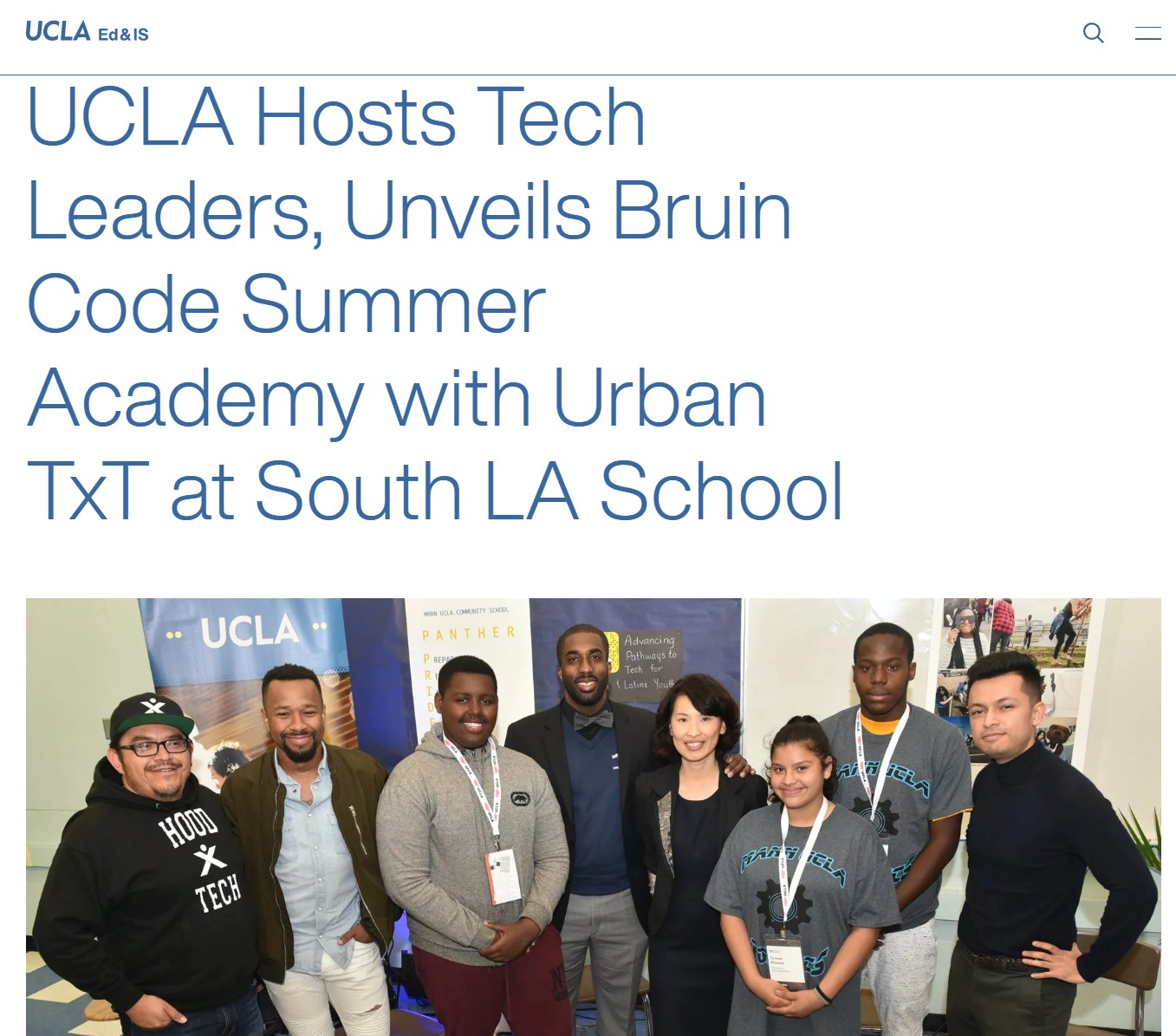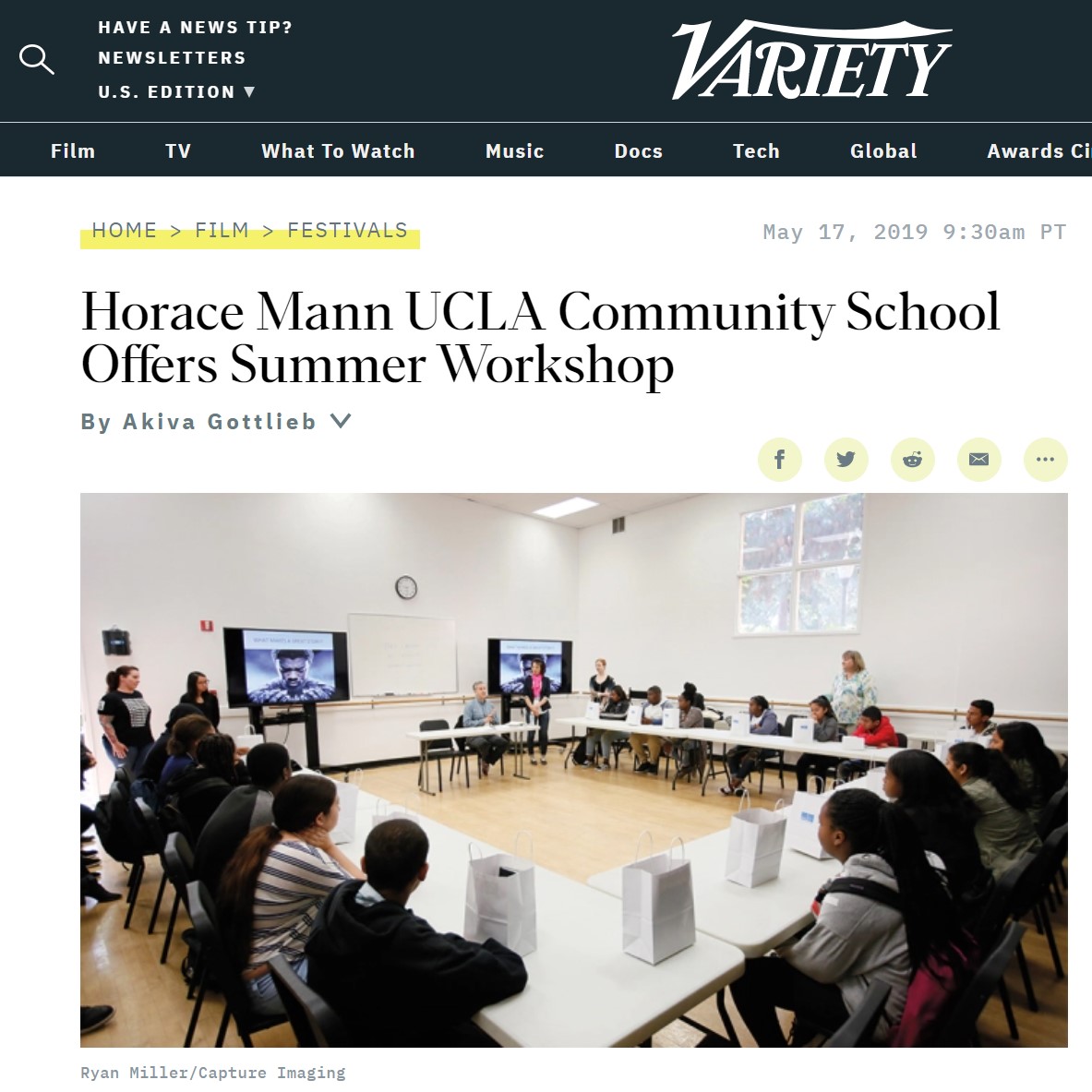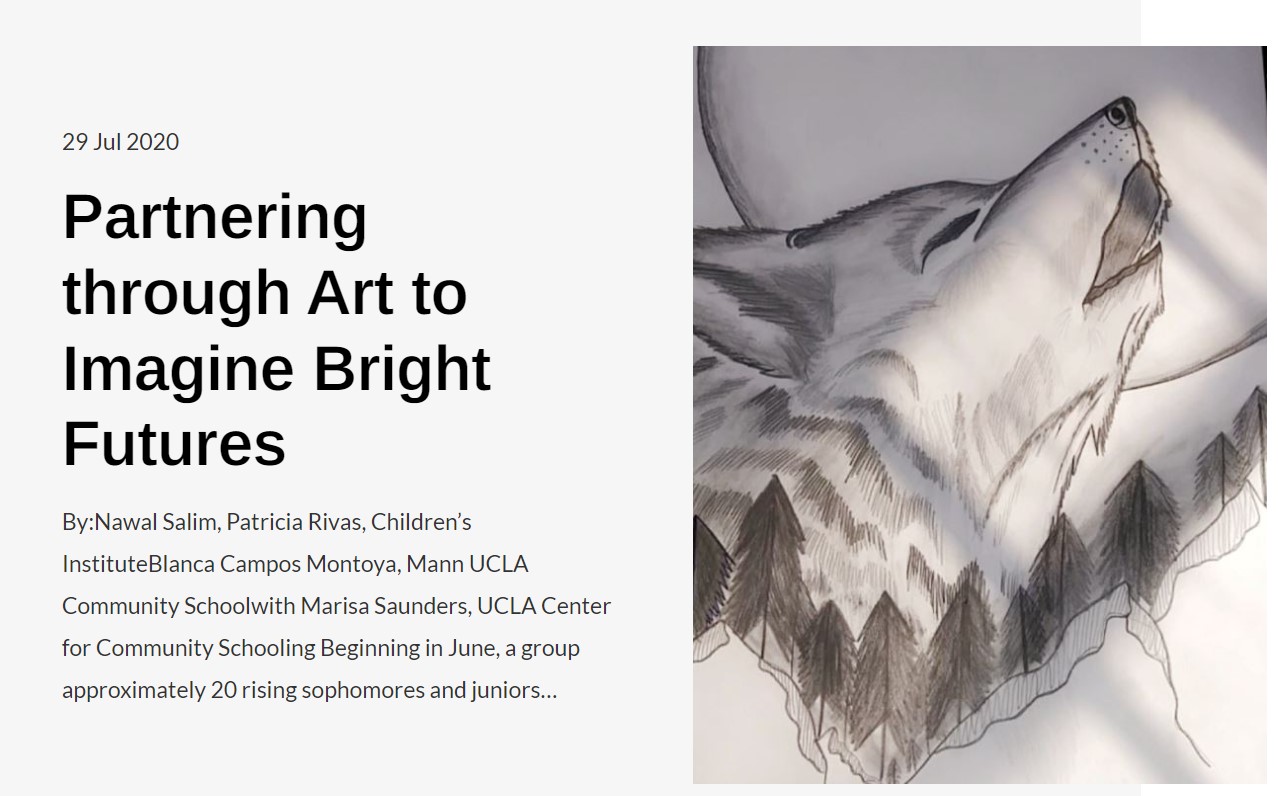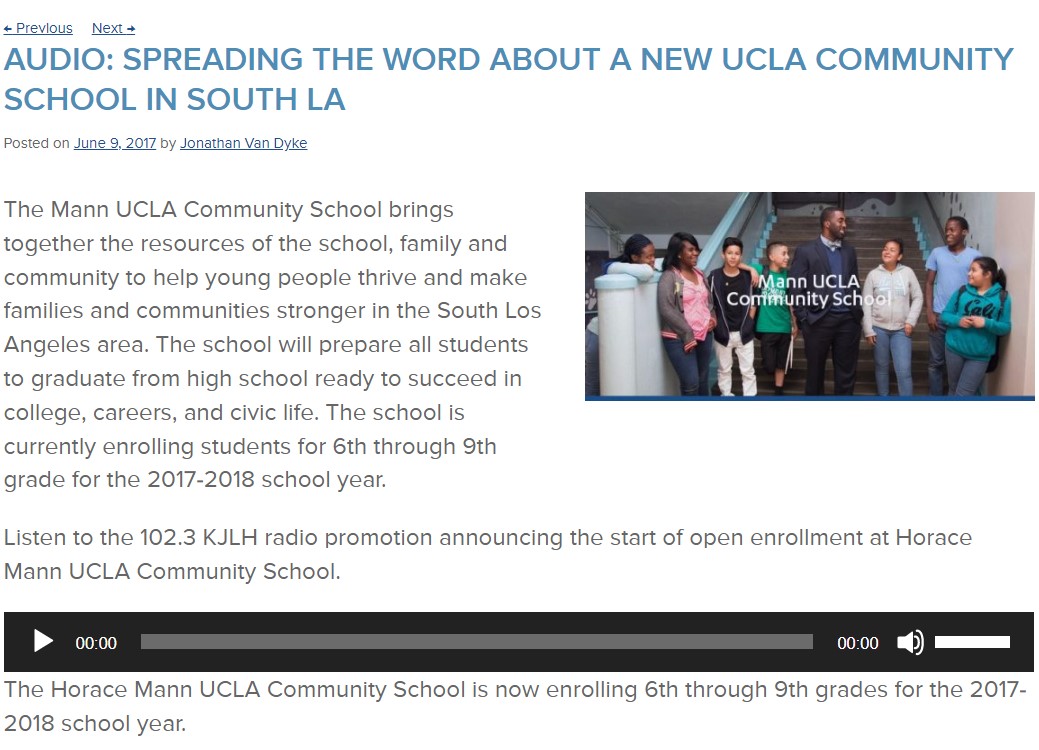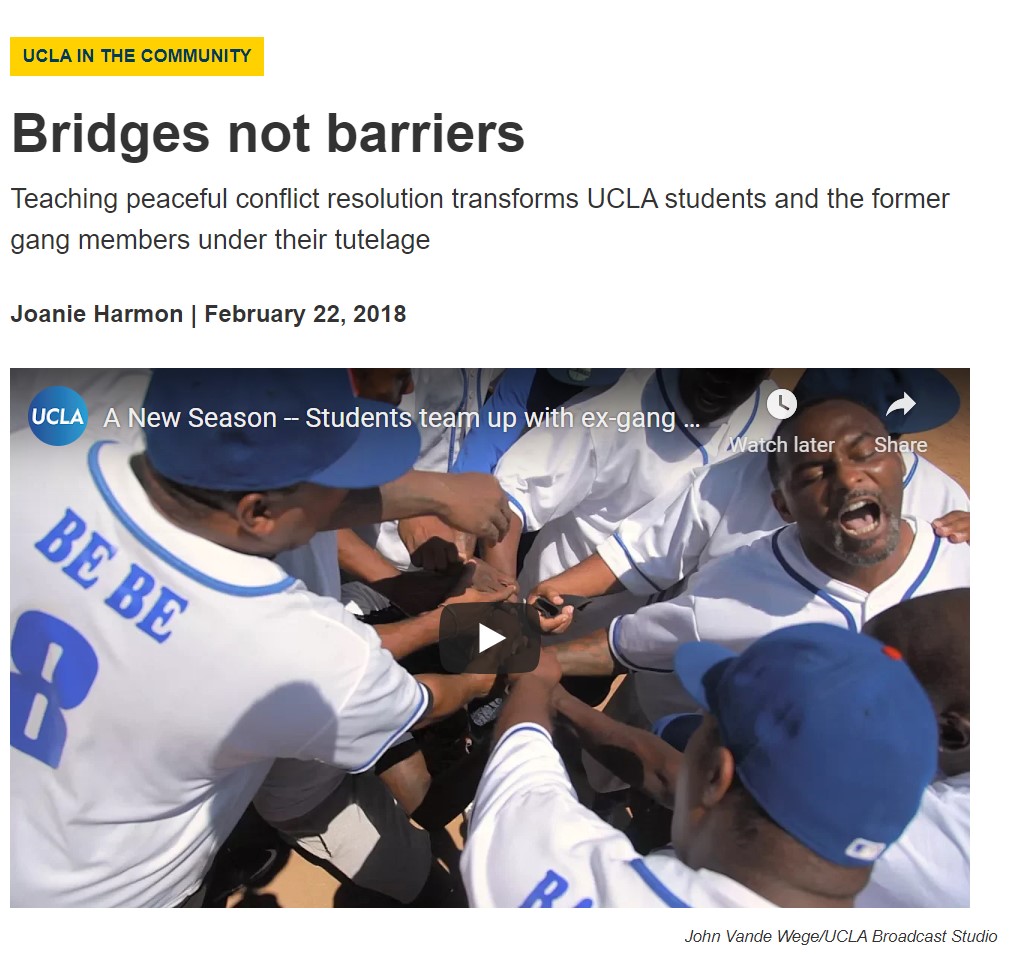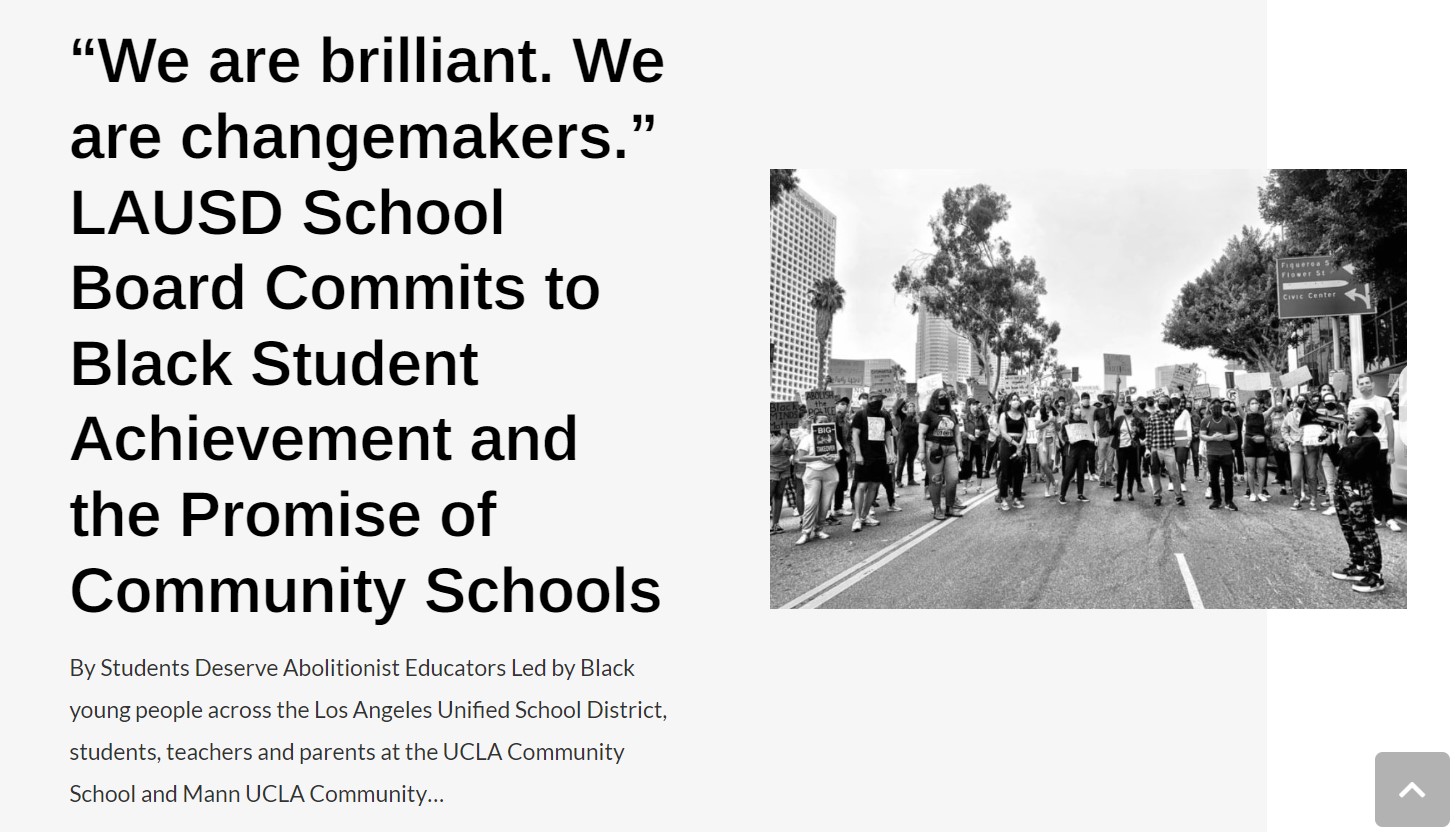Horace Mann UCLA Community School
Stability, Agency, and Love
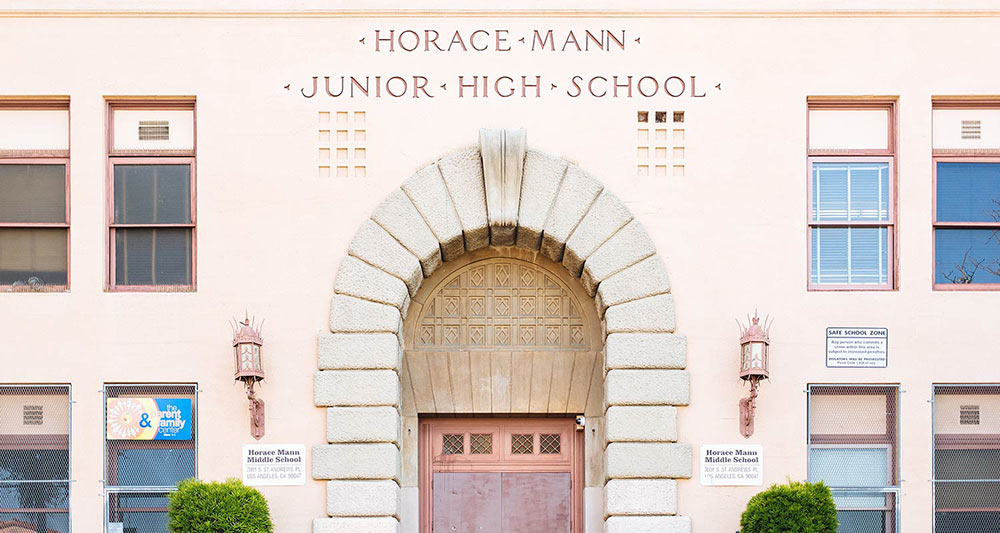
Place & People
Horace Mann UCLA Community School is a public school that has proudly served its neighborhood for almost a century. Located near the intersection of Florence and Western Avenues in South Los Angeles, the 1926 building stands tall, surrounded by well-kept homes and sports fields. Bryan Canales, a high school senior, recalls an uncle that years ago started a local soccer team on the field. “Horace Mann is just always a meeting place for all the kids around the neighborhood. Just come hang out.” The school is also known as a safe haven in an area plagued by the social and economic conditions that foster addiction, crime, violence and poverty. Jamaica Murphy, who attended Horace Mann in the 1990s, shares how her aunt used to meet her on the front steps and walk her home to shield her from the dangers and violence in the neighborhood. Like Bryan, Jamaica experienced a sense of family at Horace Mann. “We learned what it meant to be a community with each other.”
When Jamaica attended Horace Mann, the halls were filled with close to 2,000 middle school students. Over the past twenty years, enrollment has steadily decreased alongside the rapid expansion of charter schools in the area–a trend across LAUSD, which has the highest charter school enrollment in the country. Responding to the national epidemic of school closures in Black and Brown neighborhoods, UCLA partnered with the school in 2016 to ensure Mann’s future as an excellent public school and center of the community. Enrollment has steadily grown as this historic middle school expanded to incorporate grades 9-12, and was renamed Horace Mann UCLA Community School. In June 2021, the first cohort of Seniors graduated, all with postsecondary college-going plans.
Children of many former Mann students now proudly walk the same halls as their parents did before them.“
The people of Horace Mann, like Bryan and Jamaica, represent diverse backgrounds–rich in cultural assets and knowledge. Most students are Black (48%) and Latino/a/x (50%) and many speak a language other than English. In addition, families face the challenges of poverty, with 94% of the students receiving free and reduced lunch. Most of the faculty (84%) are teachers of color and they collaborate regularly with UCLA partners who serve as student teachers, teaching artists, tutors, counselors, researchers, and more. The hallways are filled with people who have a long connection to the school. Ms. Payne has run the drum line for years and often prepares breakfast. Ms. Durazo, a former student, now administrative assistant, welcomes visitors in the front office. Children of many former Mann students now proudly walk the same halls as their parents did before them.
The Mann-UCLA partnership merges the mission of the university with the core work of K–12 schooling as a university-assisted community school. It is an example of a public cross-sector partnership that contributes resources to public schooling to study and support innovative educational practices that disrupt historic inequities in underserved communities of color. These resources, however, in no way eclipse the many challenges the school faces, located in a state that ranks 30th in the nation for per student funding. Despite funding and other challenges, the school’s faculty, staff and partners remain committed to working within the public education system—exercising their collective agency to create a powerful community of learners at Horace Mann.
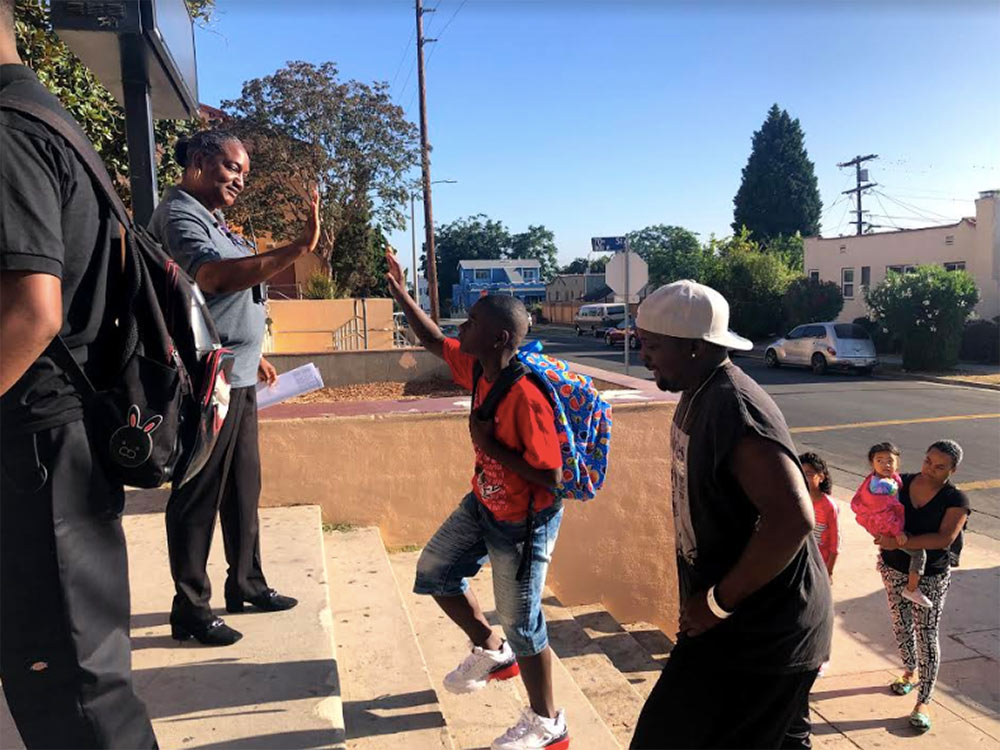
History & Vision
Horace Mann Junior High School opened in 1926 as a “pioneer” in modern education and has witnessed almost a century of social change. The school has been shaped by the racially restrictive housing covenants of the 1930s and the 1950s post-war employment boom. In the 1940s enrollment peaked and students were bused to Mann from other communities, yet by the 1970s parents started putting their children on buses in search of a good education elsewhere—a legacy fueled by agency that continues today. From 1960 to 1970, the student population changed from White to Black, and then in the 1970s on, to increasingly Latino—a reflection of its changing neighborhood and city.
Horace Mann Junior High School opened in 1926 as a “pioneer” in modern education and has witnessed almost a century of social change.“
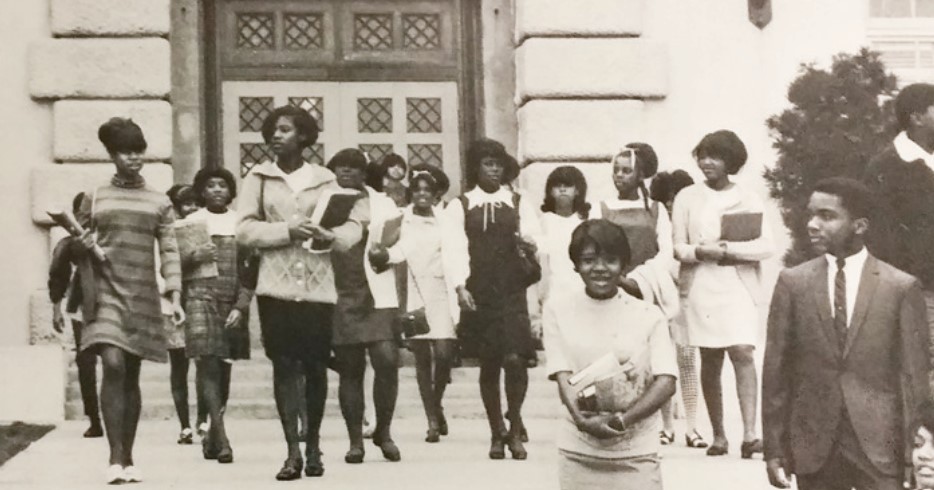
From 2001 to 2017, the school’s enrollment fell from over 1900 to 312 students as the number of charter schools within a 2.5-mile radius increased to 37. Although many of these charter schools provide good-quality options for families, their concentrated presence has created challenges. Since 2006, there have been five efforts to co-locate charter schools on Mann’s campus—following the passage of Proposition 39 in 2000 to ensure that all public school students share equally in district facilities. Only one of these efforts succeeded, in 2016, but the charter school closed the following year. Attempts to improve the school during this time have been many, including a tumultuous district reconstitution in 2011 that “hurt the school and chased away good people,” according to one teacher.
In 2016, UCLA partnered with Mann to help reimagine the school as a community school, building on the strengths of the community with an appreciation of Mann’s past and ready to help create a bright future. To reverse a 16-year trend of declining enrollment, the partnership kicked off by establishing a set of four core competencies to anchor the school’s vision as a community-based, learner-centered, university-assisted school. The school expects all members of its community to be:
- Self-directed passionate learners
- Masters of academic content and skills
- Globally and culturally competent
- Active and critical participants in society.
To do this, the school takes a “Learn-See-Do” approach to project-based learning–making connections for students between what they are learning in school and real-world applications. Field trips, enrichment programs, guest speakers, socio-emotional supports, and other experiential activities allow students to deepen their understanding of core academic concepts and develop strong identities.
We turn now to three stories that capture what it has taken over the past six years to establish and grow the Mann UCLA Community School. From a middle school struggling to remain open to a vibrant secondary school that strives to prepare all of its graduates for higher education, we focus on the foundational role that history and stability play in neighborhoods that experience trauma, racism, and poverty, the importance of supporting and embracing student and parent agency, and the power of love to guide this journey.
Public Scholarship
Stability
On June 9th, 2021, the inaugural graduating class of Mann UCLA Community School walked the stage. Thirty-eight powerful scholars were lauded, celebrated, and showered with love in a ceremony few will forget. It was a smaller outdoor gathering due to the pandemic, with many joining online. Like many of his peers, graduating senior Akili Woods entered Mann as a 6th grader. Reflecting on remote learning during the pandemic, he said “School is what really kept us together the most.” Akili is currently a freshman at Grambling State University and visits the school regularly inspiring future graduates.
School is what really kept us together the most.“
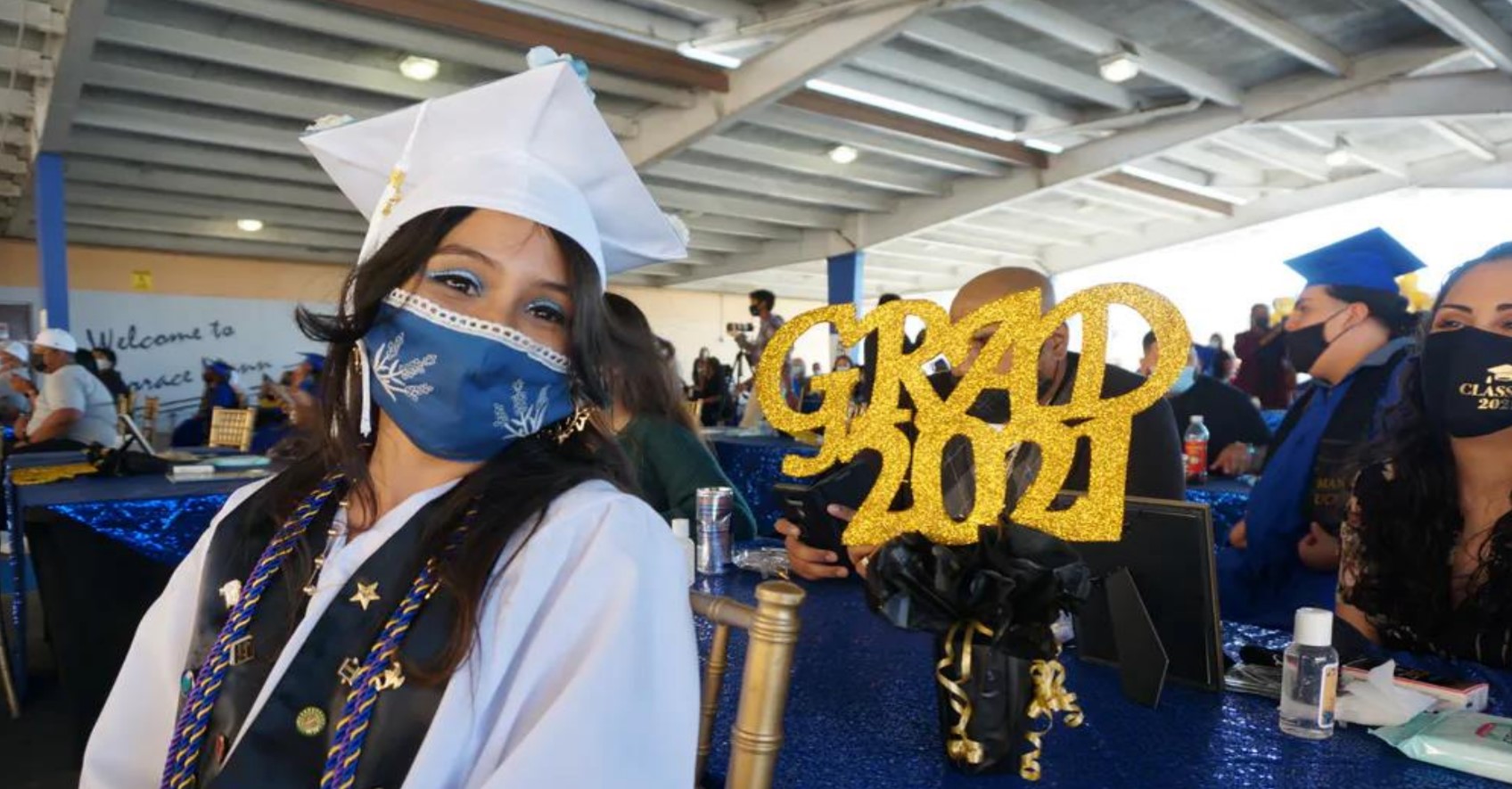
Jamaica also returns often to share her story. “The school opened the same year my aunt was born,” she recalls. It wasn’t called a community school, but “conceptually, yes, it was a community school. You came here and you got all of your needs met…these layers of people that you felt comfortable with and that you knew had your best interests.” Jamaica describes the rich set of activities that engaged her at school from early morning to dinnertime, calling the school a “staple” in the neighborhood. Today, Jamaica helps care for her aunt while she completes her PhD in education at Harvard and provides counseling to youth. In 2019, she received the first “Distinguished Graduate Award,” an effort to lift up the school’s history and alumni.
Not all students shared Jamaica’s positive school experience. Bryan’s brother and two sisters attended Horace Mann in 1998, 2002 and 2006, during the time of its declining enrollment. They experienced the school as unstable and dangerous, “somewhere where it’s hard to find someone reliable to go to.” Like his siblings, Bryan entered Mann in 6th grade, but when it came time to choose a high school, his parents wouldn’t let him stay at Mann because of its negative reputation. Instead, he attended a local charter school. “It was really buttoned up. And it was really restricted. …It wasn’t the same as here. I couldn’t just go to somebody.” After his fall semester of 9th grade, Bryan returned to Mann where he has flourished, supported by a team of caring and reliable adults.
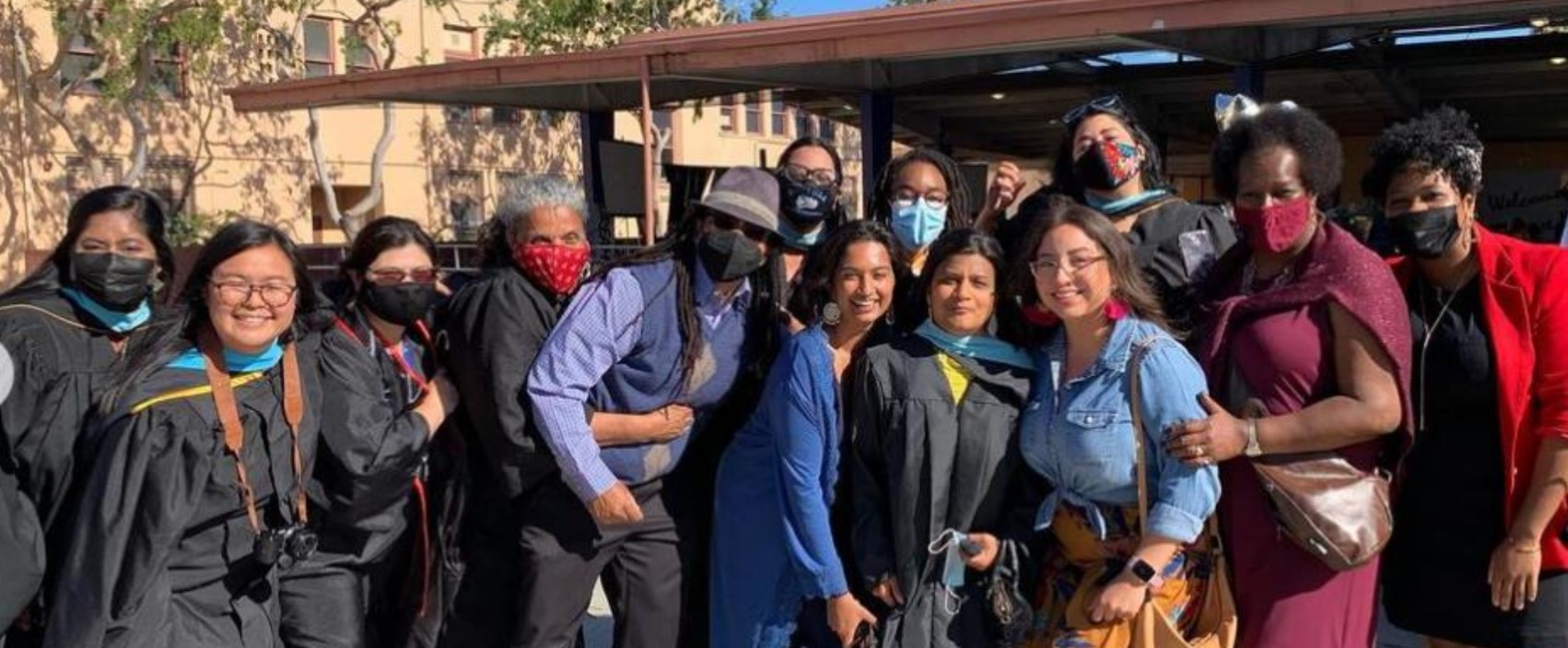
Building the school’s stable faculty was the partnership’s first big win. Revolving leadership, serial reforms, and a long held reputation for being a tough place to work had resulted in nearly half of the classrooms being staffed by substitute teachers, including the entire 7th grade team. Backed by a local autonomy agreement in 2017, the school secured the ability to no longer accept “must place” teachers and control their own hiring process. The partnership with UCLA helped create a pipeline of new teachers to the school who joined with veteran staff to create a stable and nurturing school culture. Being a new teacher at Mann is still challenging, but they are now paired with veteran teachers who provide support and help them navigate successfully through their struggles. Resources for professional learning and development increased including two blocks of time per week for collaborative planning. By 2018, there was a full slate of committed teachers on staff. By 2021, the average annual teacher retention rate was 93%, although this is expected to drop in 2022, mirroring the national pandemic-related uptick in teacher attrition. Amid this unprecedented stress, the staff that remains is committed to making Horace Mann the first choice again for the children of the community.
“I think that I really understood what a community school was–not just a name, but I felt the sense of what it was and what it embodies.”
Students are quick to appreciate their teachers. As a 12th grader shared: “They did everything they could to make sure that we had the same education as kids with a higher privilege of education. And being that the school is so small and that the people there you’ve known for a long time, I think that I really understood what a community school was–not just a name, but I felt the sense of what it was and what it embodies.” A teacher elaborates on the value of community schooling: “It’s important that they stay within their neighborhood because we are the people they are going to grow up with. The teacher that was there could possibly be the teacher that was there when your brother was there, could possibly be the teacher when your mom was there, when your dad was there . . . so having that legacy makes you feel good.”
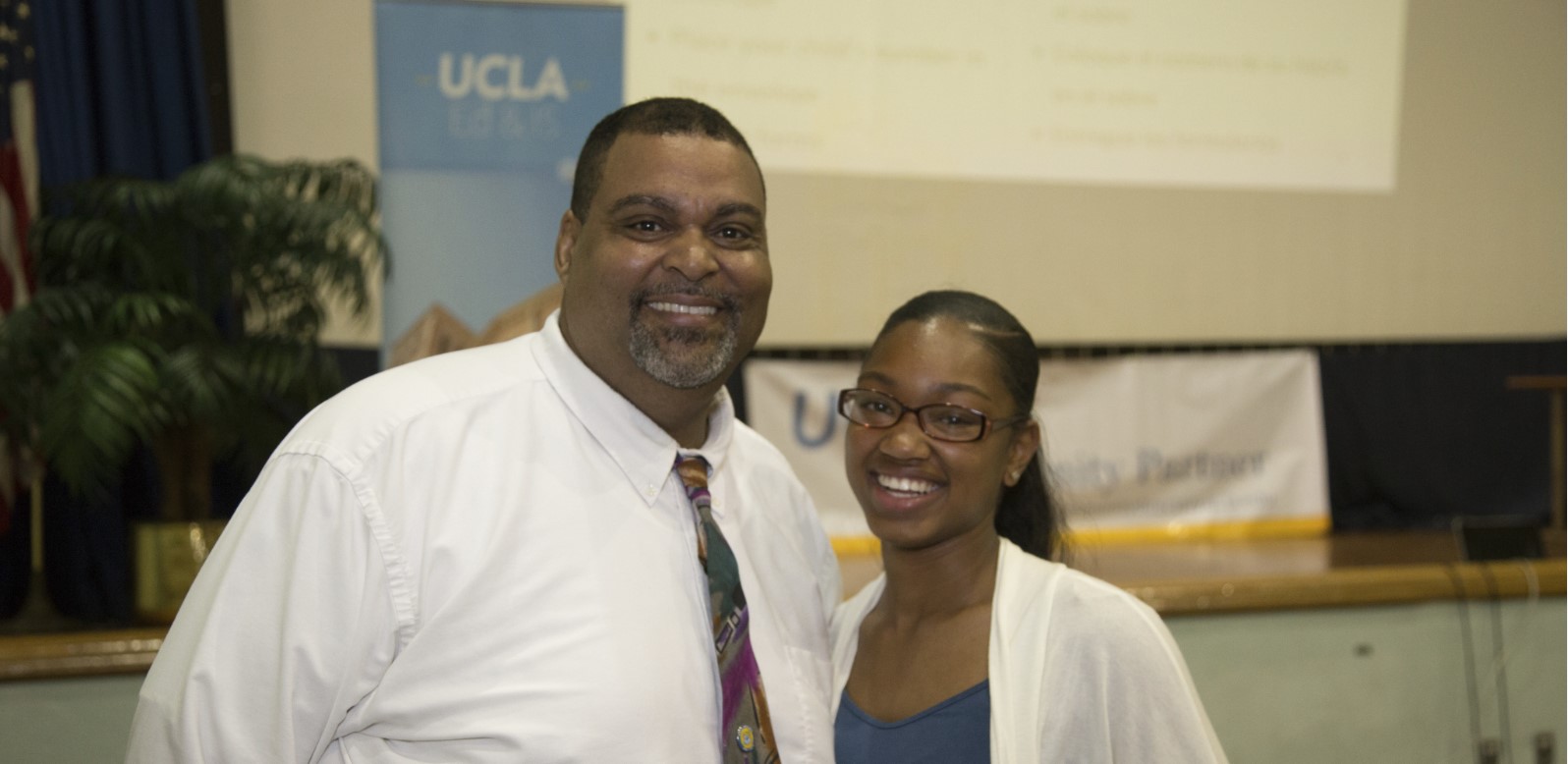
Agency
In 1950, a Mann student wrote a moving essay calling her peers to action: “We, the youth of America, have the power to wipe out prejudice.” Developing voice and agency as a young person is foundational to a good education. Yet the messages low-income students of color hear about their communities are often disempowering. Each morning for the past fifty years, buses have lined up in front of Mann to take students out of their community. As one student put it, “It’s just a mindset, I’ve got to go someplace else.” This agency to leave Mann grew with the opening of local charter schools, some that actively recruited on the school’s front steps.
Horace Mann has always had a complex relationship with its community. In the 1980s, rival gangs used different entrances because the school bordered competing territories. When Marguerite LaMotte was Mann’s principal at that time, she confronted gang members to create safe passages for students to walk to school. “She was right out of Brown vs. the Board of Education,” recalled a district board member. In 1992, the flashpoint for the Rodney King racial uprisings was around the corner from the school. To help the community heal, programs and resources flowed to the school, such as Teamworks funded by the Michael Jackson Foundation to mentor youth and provide after-school and summer enrichment. But as enrollment declined, so did these investments.
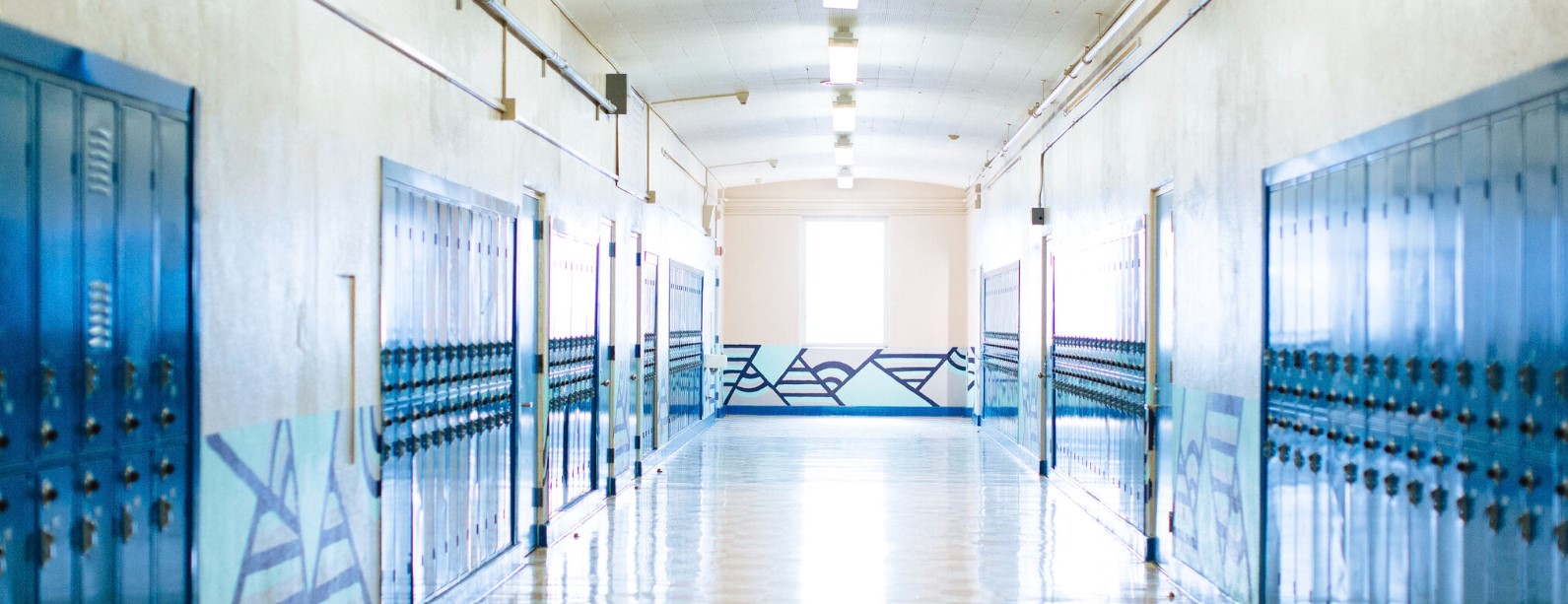
By 2016, the campus felt like a ghost town. Once again, the school was on the front lines of the civil rights movement, struggling to remain open within a newly created marketplace of school choices. The 312 students who remained at Mann included many fine scholars, yet, as a whole, students who faced the most challenges were overrepresented, including students with special needs (29% vs. 13% statewide), foster youth, and students who had been expelled from other schools. Annual enrollment picked up each Spring, right before testing season as low-performing students from local charters were asked to leave. This was the foundation for building a caring and inclusive community where all students felt valued.
Students develop their agency to make decisions and take actions when they are in social contexts that encourage exploration and affirm their identity. For this reason, the Mann-UCLA partnership kicked off with a summer institute for students, full of enriching activities at the school, field trips across the city, a screenwriting program at UCLA, and a culminating week at a summer camp in the mountains. It’s difficult to overstate the impact this experience had on students and their families that first summer. Summer enrichment was followed by extended learning throughout the school year, including college field trips, coding, Robotics, art therapy, and mentoring opportunities. The high school program was designed to be college-prep, including calculus, ethnic studies, physics, and Mandarin. These learning opportunities send a clear message that all students are valued and have bright futures. As one Senior shared, “They told me anything is possible. There’s so many subjects, so many things you can do. So open your mind to more things, not just narrow it down to how society wants you to do things.”
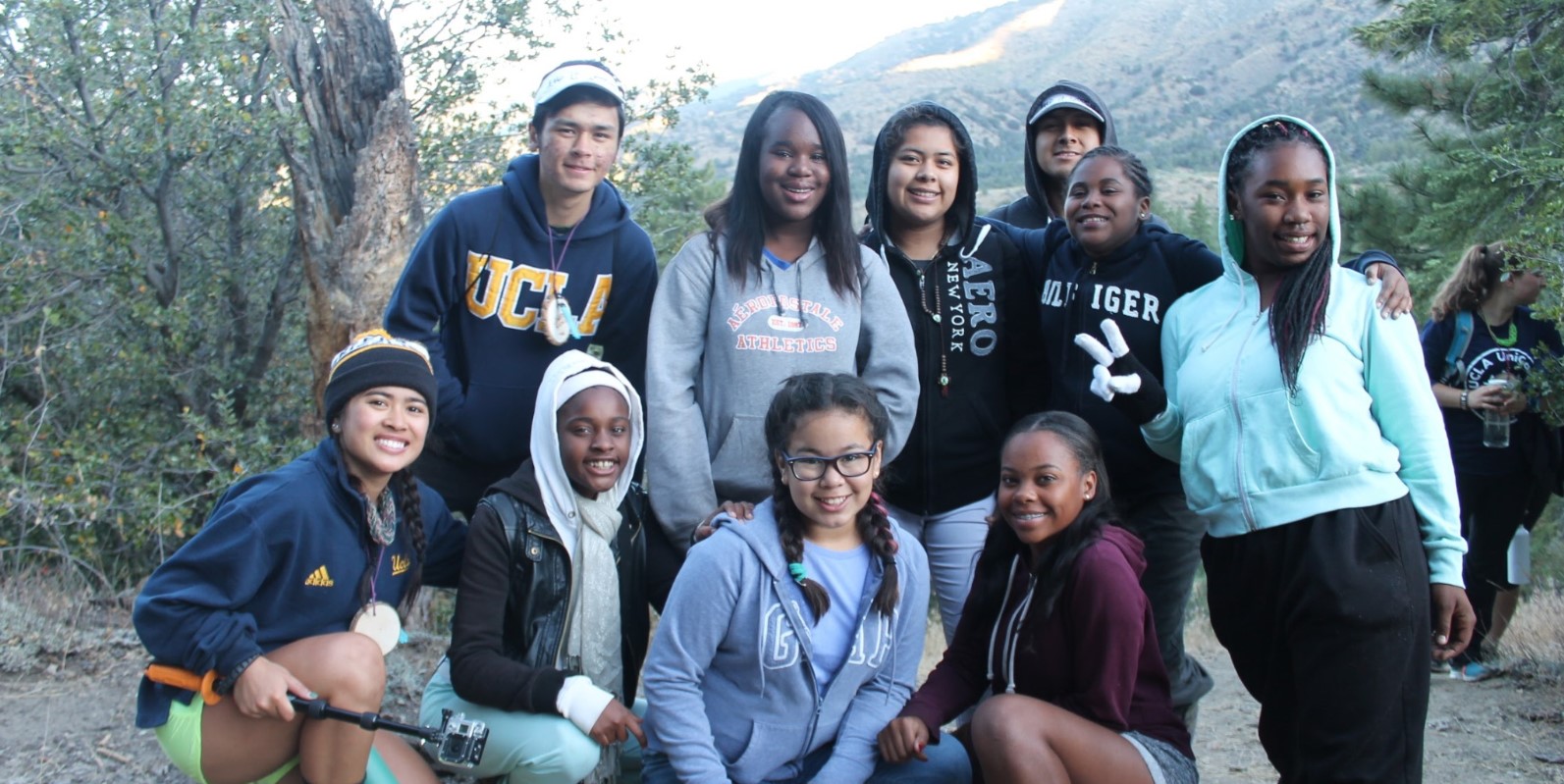
They told me anything is possible. There’s so many subjects, so many things you can do. So open your mind to more things, not just narrow it down to how society wants you to do things.“
In response to the agency of local families to choose other schools, a local pastor shared, “I think the challenge is for parents to feel that the schools in their neighborhood are the best schools.” To help sway parent’s minds and compete in the crowded marketplace of school choices, Mann printed fancy brochures, made lawn signs and banners, and even produced a local radio ad. Convincing 8th grade students to stay for high school was another challenge. Traditionally, students from Mann head to one of three nearby high schools, with long histories and prominent sports programs. As a result, less than half of 8th graders stayed on. This number was starting to tick up until the pandemic leveled another blow–families suffering from COVID and an enrollment decline of more than 100 students, many leaving the school for online learning. As schools shutter across the country due to COVID, Mann is working hard to be a hopeful place of neighborhood renewal and agency.
Love
In 2016, Bryan was in sixth grade—a year he remembers as “nonstop detention” and policing on campus. “We would just be in class and the school police would just bust in the door, and just take up the whole class and just empty your pockets, just go through all of our stuff…it didn’t feel right.” Changing this punitive school culture took time, an ethic of care, and resources, such as UCLA conflict mediation programs. Bryan noticed the change within a couple of years. More counselors, community circles, and a restorative approach to conflict helped heal relationships between students and adults. They “eventually saw me in a peaceful manner,” Bryan shared.
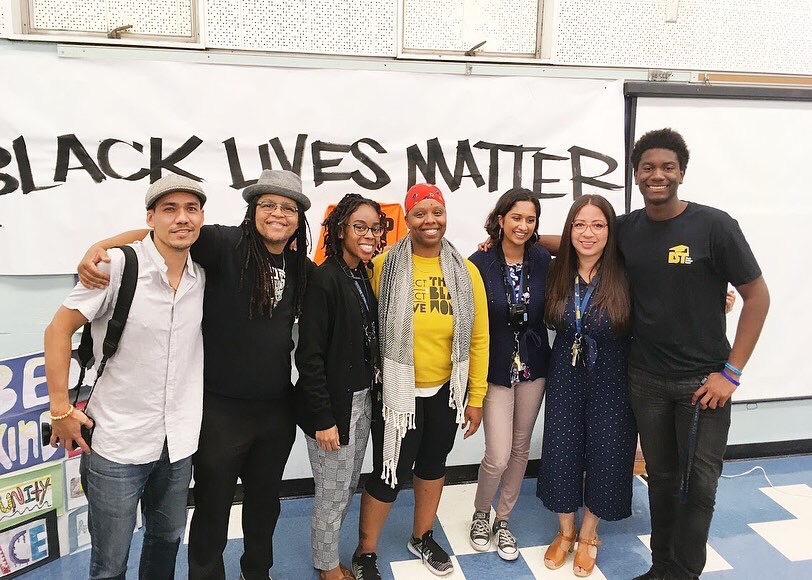
On November 5th, 2019 the school invited Patrisse Cullors—revolutionary, author, activist, and co-founder of the Black Lives Matter movement—to share her story with students and help them feel more connected to their identities, self-worth, and community. As Cullors advocates, “We will not stop fighting until every single black life is provided the type of love and support we so desperately deserve.” The racial reckoning of 2020 was another opportunity to affirm love and peace, igniting an Anti-Racist Committee at the school and student organizing to defund school police. In 2021, the school received additional counselors and programs as part of the district’s Black Student Achievement Plan and UCLA partnered with Children’s Institute to plan a mental health clinic on campus. The partnership’s next chapter will focus on the infrastructure needed to integrate and align these much-needed student supports and track their effectiveness over time. To date, service provision has been more triage than a coherent system of support.
I have millions of stories about how all the adults at Mann have come in clutch for me at one point or another…Because we’re a family.“
The last six years of rebuilding Mann has been a full court press, fueled by idealism, solidarity, and love. The school organizes picnics, celebrations, and activities that promote fellowship. When the pandemic hit, care packages went out to families and teachers reached out by phone, text, and Instagram accounts to connect with students. When Seniors crossed the stage in 2021, they received a laptop and were assigned a mentor. A few staff members even moved students into their dorms. One Senior shared, “I have millions of stories about how all the adults at Mann have come in clutch for me at one point or another…Because we’re a family.”
Conclusion
By centering love at the core of its work, Mann seeks to humanize education and disrupt deficit notions of students of color. When teachers and other adults know students well, they can see their strengths and respond to their needs. They can track them down, believe in their promise, and hold high expectations. As Bryan puts it, “People here at Mann go through things with you, instead of just help you with it.” Expanding Mann’s grade span from the middle grades through high school has helped build these strong relationships with both students and local families. Offering a college-prep curriculum and a variety of expanded learning opportunities and supports has helped prepare students to be both self-directed passionate learners as well as active and critical participants in society.
People here at Mann go through things with you, instead of just help you with it.“
The challenge now is sustaining the momentum. The pandemic has leveled unprecedented stress on schools and communities of color like Mann. Teachers, staff, and partners have experienced the human toll of going through trauma with students and the entire community needs to collectively heal and continue to receive supports and resources. This will always be challenging work; as one teacher describes, “it’s a beautiful struggle”. When Jamaica returns to talk with students, she shares: “I think that it’s important that they do understand that you can sit in these seats, and you can have challenges and a difficult life, a hard life through no fault of your own. And then you can overcome that and then reach your goals.” By supporting one another, the Mann UCLA Community School is working hard to reclaim its place as a cornerstone of public education in South Los Angeles.
About the Authors
Greg Amelio has had the joy of working at Horace Mann as an English teacher since 1994. He was a part of the design team to develop the Mann UCLA partnership in 2016. He loves to help students find their unique voice and uses his voice as an advocate for their well being. He takes great pride in watching Mann students shine.
Karen Hunter Quartz directs the UCLA Center for Community Schooling and led the design team in 2007 to create the RFK UCLA Community School. She also served with Greg on the design team, in 2016, to establish the Mann UCLA Community School. Karen’s research, teaching and service support community school development, teacher autonomy and retention, and democratic educational reform.
10 MINUTE READ
This case introduces you to a particular community school journey, which is intended to help you think about your own journey to create, develop, or support community schools. There are resources in the sidebar to dig deeper on particular topics and a discussion protocol designed to be used in a faculty meeting or professional development workshop. If you use these resources and have any feedback that might strengthen future school cases, please let us know.
TABLE OF CONTENTS
REPORT LINKS
RESOURCES
To explore the school’s history and experience further, check out these videos, reports, lesson plans, magazine articles, and more. These resources are curated to speak to different audiences, including teachers, researchers, policymakers, and the general public.
CITATION
Ameilo, G., Quartz, K.H. (2022). Horace Mann UCLA Community School: Stability, Agency and Love. Community Schooling, Issue 2, Spring 2022.
ACKNOWLEDGEMENTS
Many people helped us craft this story and we are grateful for their help. In particular, we acknowledge the student insights shared by Jamaica Murphy, Bryan Canales, Akili Woods, and many others. We are also indebted to Cora Watkins and José Muñoz, both members of the journal’s editorial board, for their careful review and suggestions. The companion video was produced by UCLA undergraduate student Regine Villarmea with support from the journal’s co-editor Marisa Saunders. We are very thankful to them as well as our Mann colleague Floydette Gibson who narrated the video.
REVIEWERS
This report benefited from the insights and expertise of two external reviewers: Xavier L. Cason, Director of Community Schools and School Transformation for the Durham Public Schools Foundation in North Carolina; and Terry Kim, Director of Government Relations & Advocacy for Children’s Institute in California. We thank them for their helpful feedback.


